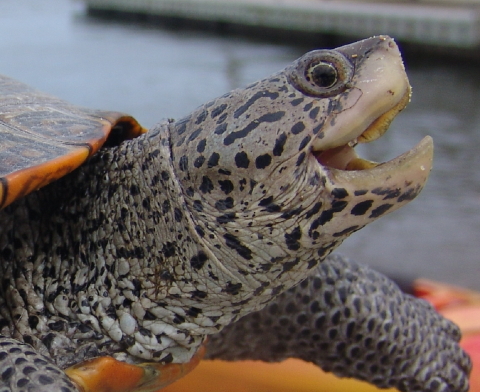8-Year-Old Female Diamondback Terrapin #35
Capturing the first diamondback terrapin (Malaclemys terrapin) of the season in the Great White North demanded daring, skill and an abundance of luck. Â Yet, in the field of research, fortune favors the prepared mind. Â Kayaking in 45 mph gusts is foolhardy. Â Kayaking in 45 mph gusts with a 10 foot net to catch the wind is crazy scary. Â Hoping to see, let alone net, an elusive terrapin in the churned murky chocolate waters of Sippican Harbor defines lunacy. Â But fortune smiled on the Turtle Journal team Monday, April 14th, and Terrapin #35 — a young 8-year-old female — became the first capture of the 2014 research season.
30 MPH Southwest Winds with 45 MPH Gusts
We had seen a male and female pair of terrapins cavorting in the Sippican Harbor mating aggregation at noon on Saturday. Â On Sunday, Turtle Journal returned with kayaks in a 20-knot southerly breeze to try for the first capture of the year, but conditions proved impossible for turtles and turtlers. Â With winds increasing to 30 mph on Monday with 45 mph gusts out of the southwest, we knew that conditions had only gotten worse. Â Still, the forecast for Tuesday called for rain, followed by temperatures dipping into the 40s for Wednesday and Thursday. Â Despite the odds, things would not improve any time soon. Â We packed up the kayaks and off we went to Marion’s town landing.
Sue Wieber Nourse Paddles Sippican Harbor
Conditions were actually worse than we imagined. Â Kayaks were tossed by the gusts, and when wind hit the nets at the “right” angle, they became airfoils that lifted our boats like kites. Â To call the experience exciting understates the adrenaline rush. Â The fresh southwest breeze blowing up the harbor churned the estuary into the color of Navy mess coffee with a couple of hits of espresso for good measure. Â Maneuverability: nil. Â Visibility: zero. Â Control: Â none.
Don Lewis Kayaks Head of Harbor Shallows
We know these waters very well. Â They comprise the major brumation site and mating aggregation within Sippican Harbor. Â The bottom of Head of Harbor is composed of a thick, oozy layer of quick mud. Â One gust blew so hard it drove Don Lewis and his kayak into the shallows and grounded the boat in the ooze. Â To extricate himself, Don dug his oar into the black slimy mud and painstakingly edged the kayak to open water. Â As he placed his left side of the paddle in the ooze, he heard a clink. Â Don thought, “There’s no rock here.” Â He gently tapped the bottom and discovered that the “rock” had moved about a foot. Â Don substituted net for oar and scraped. Â He raised the net with about 30 pounds of congealed muck. Â Using the net as a sieve, Don carefully sifted the mud like a 49er gold miner, and sure enough, he hit pay dirt: Â a very surprised Terrapin #35.
Don Lewis Examines Female Diamondback Terrapin #35
Suppressing shock and surprised, we paddled the mile back to the landing and examined our treasure. Â Diamondback Terrapin #35 is a young, mature 8-year-old female. Â She was first captured by the Turtle Journal Sue Wieber Nourse on April 29th, 2013.
8-Year-Old Female Diamondback Terrapin #35
She weighed 2 1/3 pounds and her shell measured 7.2 inches long.  In the last year she had grown a 1/3 of an inch in length, and Terrapin #35 looked extremely healthy after a long winter’s slumber.
Sue Wieber Nourse Release Diamondback Terrapin #35
After collecting scientific data and examining her carefully, we immediately released her back into Sippican Harbor to join her invisible cohorts within the Head of Harbor mating aggregation. Â Terrapin #35 is a young mature female and we hope this year to discover her nesting location. Â As with most diamondback terrapin populations, the paucity of safe upland nesting locations along the developed Sippican coastline forms the greatest threat to their survival.






